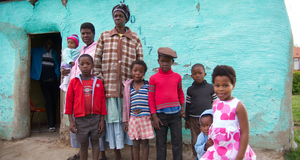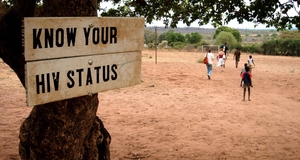Featured Article:Controlling and Preventing HIV in Southern Africa
By
2009, Vol. 1 No. 10 | pg. 2/2 | « Prevention Methods and ChallengesSexual behavior and insufficient male circumcision represent the fuel for the HIV epidemic occurring in sub-Saharan Africa, but more importantly, they should be viewed as the means by which the course of the epidemic can be changed. Campaigns for behavior change face real challenges. Sexual behavior is a deeply embedded human trait which many people will be reluctant to change. One author compares the challenge to our experience in trying to change other human behaviors, such as diet and exercise, and cigarette smoking.1 However, when people are faced with “guaranteed death”—as one poster from the Ugandan Zero Grazing poster proclaims—a considerable incentive is provided. And where significant, targeted campaigns have been supported, there has been success in the past. The Zero Grazing campaign provides a well documented example, with WHO surveys indicating a “60% decline in the percentage of people reporting two or more sexual partners in the previous 12 months” from 1989 to 1995.4:22 However, Halperin and Epstein also cite campaigns in Kenya, Zimbabwe, and Swaziland that led to significant partner reduction—as high as 50% in Swaziland and Zimbabwe.4:23 The evidence shows that campaigns to change sexual behavior, through education, community mobilization, and social-political campaigns, are needed in order to curb HIV incidence to manageable levels.To promote safe sexual behavior, realistic goals and apoliticized standards need to be adopted. Currently, funding for AIDS is plagued by dollars with political strings attached. The United States Presidents Emergency Plan for AIDS Relief (PEPFAR), which represented about 21% of the $10 billion in annual resources available in 2007,12:188 is notorious for its political conditions. One of these conditions has limited funding to HIV prevention efforts not focused primarily on abstinence. Currently about a third of all resources allocated for prevention by PEPFAR are spent on abstinence-only campaigns, but it is possible to put the number at closer to two-thirds when discounting for funding to mother-to-child transmission dollars (which account for 29% of total funding for prevention, despite the fact that “the vast majority of adult HIV infection in sub-Saharan Africa results from sexual transmission.”14).8 Promoting abstinence-only as the primary means of prevention imposes a decidedly ideological viewpoint on a problem that needs a realistic, scientific response. Considering the need for such an evidence based response, male circumcision is emerging as a highly effective biomedical intervention. Three recent clinical trials conducted in Africa concluded that MC reduced risk for HIV by “at least” 60%.9:750 While some claim that MC should not be seen as the “silver bullet” in combating HIV, all available evidence illustrates conclusively that MC is highly effective and should therefore be a central component of comprehensive HIV interventions in high-prevalence areas: “The benefits of male circumcision are clear: it is a once-off, effective procedure that is unusually culturally acceptable and sought after in many parts of Africa. In addition, male circumcision provides a rare and important opportunity to access a hard-to-reach population—sexually active men at high risk of HIV exposure—with a potentially life-saving intervention.”14:402 Male circumcision also has the potential to provide a significant cost-benefit over other interventions. Especially considering the fact that it is a one-time procedure, one can estimate that with reasonable investments made to scale-up capabilities, MC would be a highly cost-effective method. Auvert, et. al. found that over a 20 year period up to $2.3 billion could be saved in averted infections, concluding that though “substantial funding” would be required in the first five years, “lower ongoing costs and continued care savings suggest long-term sustainability.”2 On the other hand, the oft-emphasized method of HIV prevention—the increased use of condoms—has been shown to be minimally effective in the context of generalized epidemics, despite its relatively high efficiency in controlling HIV in high-risk populations elsewhere (such as MSM in the U.S. and sex-workers in Asia). The drop in efficacy in Africa is directly related to the different patterns of transmission and sexual behavior: “Although condom use has also likely contributed to HIV decline in some generalized epidemics, there is no evidence of a primary role. This is because consistent condom use has not reached a sufficiently high level, even after many years of widespread and often aggressive promotion, to produce a measurable slowing of new infections in the generalized epidemics of Sub-Saharan Africa. When most transmission occurs within more regular and, typically, concurrent partnerships, consistent condom use is exceedingly difficult to maintain.” 9:749 The reality of the situation is that maintaining “perfect” condom use in long term relationships is extremely difficult—not just in Africa, but in the United States as well. In a 2003 study, researchers found that of 1181 randomized survey subjects representing the General Population (GP) in the U.S., only 50% reported using condoms in the past 5 years, despite the fact that 70% were in committed long-term relationships and 60% had a sexual event within the past month of taking the survey. The study concluded that, “Despite continued public health efforts, overall condom use remains low in sexually active adults in the US.”7 Without 100% condom use, the drop-off in efficacy for preventing HIV is significant, and this explains in large part why even a flood of condoms to Africa from the developed world has had little measurable impact. Nevertheless, donor funded resources continue to put abstinence and condom use at the center of their prevention strategies. UNAIDS estimates its allocation to funding for MC to be less than 20% of its funding for condoms, representing about 1% of its total resource allocation.12 While greater access to and use of condoms is an important goal in ultimately eliminating HIV in the general population, it is an effort that will not yield fruit on its own. To be successful, ongoing and future HIV/AIDS campaigns need to reassess their resource allocations. Organizations like PEPFAR currently spend the vast majority of their resources on treatment (which is also an essential endeavor), even though the best treatment any person can receive is—without question—to never contract the disease in the first place (prevention). By failing to invest in preventative approaches that are proven and readily available, funding misallocations become moral failures. ConclusionThe key drivers of HIV in the sub-region of Southern Africa appear to be the elevated frequency of multiple concurrent partnerships combined with low levels of male circumcision, which together create a vulnerable network through which the virus can spread rapidly. The major funding sources have nonetheless failed to fully recognize the importance of these factors in their past efforts. Examining current prevention strategies seems to reveal an idealistic double-standard, in which Africans are expected to either refrain from sex altogether or maintain 100% condom use, despite the inability of any other population in the world to meet a similar standard. Current strategies, in effect, disregard the reality on the ground in exchange for a perceived moral high ground—potentially at the cost of many lives. Reducing multiple concurrent partnerships and implementing male circumcision on a large scale represent areas where future prevention efforts should focus. MC is a biomedical intervention that is safe, effective, and ready to be put to work in severely affected regions. Though MC does not represent a “cure-all,” by implementing the practice as part of a comprehensive strategy—which should include efforts to increase awareness, reduce multiple partnerships, and also encourage conventional methods such as improved condom use—it is highly likely that a significant number of future HIV cases can be averted. References
Suggested Reading from Inquiries Journal
Inquiries Journal provides undergraduate and graduate students around the world a platform for the wide dissemination of academic work over a range of core disciplines. Representing the work of students from hundreds of institutions around the globe, Inquiries Journal's large database of academic articles is completely free. Learn more | Blog | Submit Latest in Health Science |


















